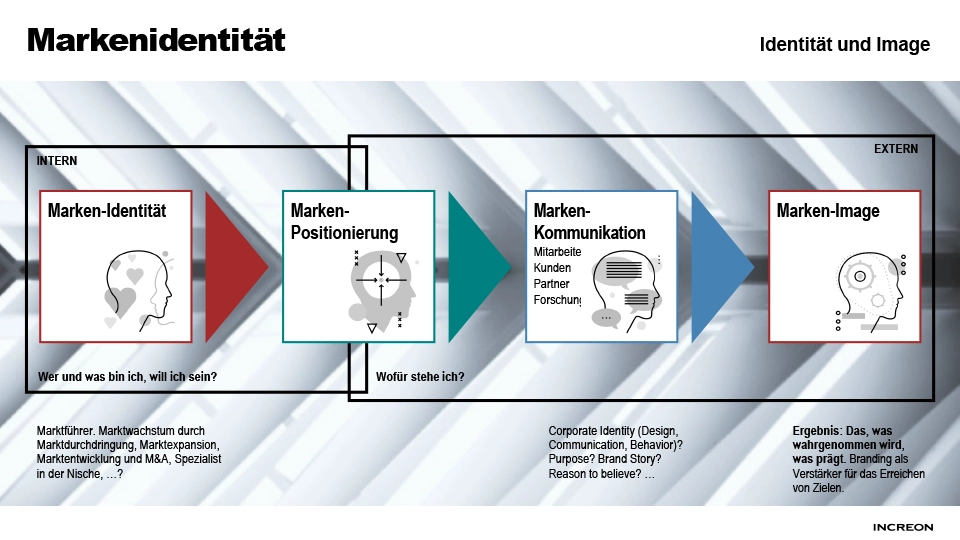

Brand Identity
Brand identity is what makes companies from industry and technology and their B2B brands unmistakable and recognizable. It is individual and unique. It has something personal. Brand identity develops over years and usually changes only slowly. In brand consulting, we work with clients to identify these unique characteristics.

HOW IS BRAND IDENTITY CREATED?
Unique, personal brand identities develop over years.
Brand identity grows from the moment a company is created or a brand develops. Who has a formative influence on the brand identity at the beginning? The first large influence is from the founders, the entrepreneurs, who influence the young identity with their personality, ideas, and concepts. The next formative influence is the environment, which consists of employees, customers, and stakeholders of all kinds. These early influences shape companies and brands. The development of the B2B company, along with economic, political, and social changes, influence the brand identity over time. In phases such as generational change, technology and innovation spurts, strong company growth, or a new strategic orientation of the company, brand consultants believe it is time to focus on the brand, its identity, and its development opportunities. How can the existing brand identity be aligned in a way free of contradictions aimed on the future so that the brand identity makes a maximum contribution to positive corporate development? We find answers to these questions in our consulting projects.
Models for the development of a brand identity
Today, there are numerous approaches that help to develop suitable, unique, and authentic brand identities. To name just a few: the Bates Brand Wheel brand core model, the brand identity model and characteristics of brand personalities by Aaker, the brand identity approach by Meffert and Burmann, the McKinsey brand diamond, Esch’s brand steering wheel, or the identity prism by Kapferer. These are all helpful models. In our brand consulting and support for brand identity projects, we draw on various aspects of these models, combining them with our own approaches, which are based on our experience and knowledge from numerous branding projects.

Armin Bastl
Brand Consulting
Brand development is a strategic and long-term task. Do you want to know how you can benefit from it?
The brand identity becomes a brand image
Brand identity is both an anchor and driver. Brand identity helps answer three key questions: Who am I? What am I? And how do I want to be? B2B companies from industry and technology also have to ask themselves these questions — as market leaders, during strong market growth, during intensive market developments, in M&A processes, and during focusing and specialization. This brand identity, growing from within, is the basis of all brand work and brand consulting. A specifically formed brand identity supports the corporate and brand strategy, and it shapes the image in such a way that a positive momentum can develop.
Identity is the prerequisite for individuality. It sets the company apart from its competition. It shapes the B2B company and the B2B brand through the why and the how. It explains why a company exists, what drives it, and why it should continue to exist. It is the core and soul of the brand.
Brand positioning is the second step; it forms the transition to the external perception of the B2B brand. Brand positioning answers the questions: Where do we stand? What do we claim to offer; what is our value proposition? And how do we prove to the market that we mean business, that we keep our promise? A company that can answer these questions from the CEO to the trainee, each in their own words but with the same content statement, has clear positioning, a strong identity, and the chance to be perceived as an authentic market player.
Brand identity and brand positioning must become visible and tangible — to employees, customers, partners, and all other stakeholders of the company. At all of the company’s locations. At all customer touchpoints with the brand. Before the purchase, in the purchase phase and after the purchase. A memorable corporate design, credible communication, and authentic behavior of all employees of a B2B company among each other and towards the market is the foundation. The brand story and reason to believe are the reference point for brand communication.
Brand image is what is perceived outside in the market. If the first three brand functions are consistent, are visible, and can be experienced positively, a brand image will grow from them which largely corresponds to the brand identity. So if brand strategy and corporate strategy go hand in hand, the B2B brand acts as an amplifier for achieving corporate goals. Then the brand provides added value.
BRAND IDENTITY CREATES INDIVIDUALITY
If the image of your brand is different from how you wish it to be as a company or B2B brand in the market, expensive image campaigns are of little and only temporary help. If a B2B company really wants to develop further, it must ask itself the question of its identity from within and start branding work there. We support such projects in an advisory capacity.






